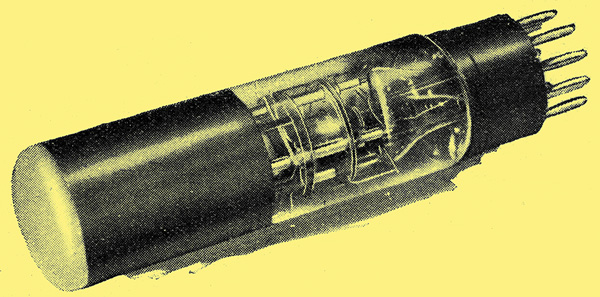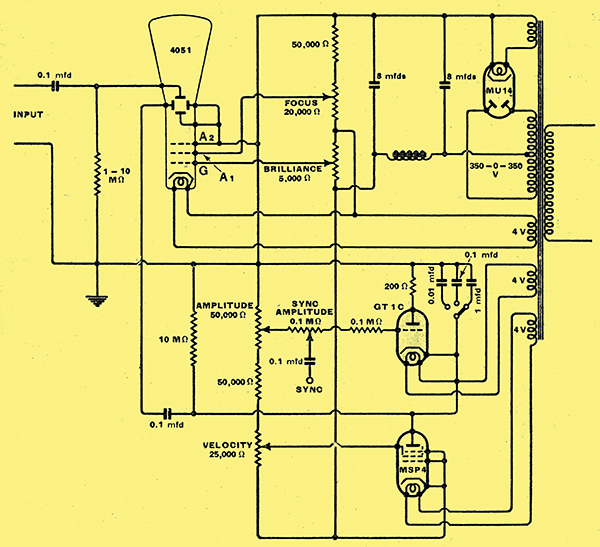|

New Miniature Type for Oscillographs.
A new cathode-ray tube of the high vacuum type has been produced by the General Electric Co, Ltd; it is known as the GEC Monitor, Type 4051. It has an indirectly heated cathode consuming 0.9 A at 4.0 Volts and is of the two-anode type. The second anode is rated for 500 Volts maximum but can be operated at lower voltages down to 250; the first anode voltage must be adjustable for focusing and should be 50-100 Volts, according to the second anode voltage. Brilliancy is controlled by the grid bias, which must be adjustable over the range of 0 to -20 volts relative to the cathode.
Two pairs of deflecting plates are included and are all brought out, so that push-pull deflection can be employed. The X-plates are those next to the second anode and have a sensitivity of 82 V mm per Volt, While the Y-plates have a sensitivity of 73 V mm per volt, where V is the second anode voltage.
The tube is cylindrical in shape with a length of about 6¼in and a screen diameter of 1½ in It has a green screen of medium persistence and is priced at 45s. It is fitted with the standard B9 9-pin base, the connections being as follows:
- Deflector Plate Y1
- Deflector Plate X1
- Anode 1
- Heater and Cathode
- Heater
- Grid
- Anode 2
- Deflector Plate X2
- Deflector Plate Y2
The circuit arrangement adopted for the tube depends largely upon the purpose to which it will be put. A suitable circuit for many requirements, however, is shown in the accompanying drawing.

Suggested circuit arrangement for use with the GEC miniature CR tube.
The tube voltages are simply obtained from a voltage divider across the HT supply. As the second anode is earthed in most oscillograph applications, however, it is usually advisable to place the smoothing choke in the negative HT lead as shown.
The lower part of the diagram shows a simple time-base, which will give a sweep frequency of about 4-4,000 Hz, thus enabling phenomena up to at least 10 kHz to be clearly distinguished. A gas-triode saw-tooth oscillator is used with a pentode charging valve to obtain linearity. The frequency of the saw-tooth oscillations is governed largely by the screen voltage of the pentode and the amplitude by the grid bias of the gas triode. As is usual with timebases, however, each control governs frequency and amplitude to some degree.
The input work voltage needed naturally depends upon the anode voltage. If this is 350 Volts, the sensitivity is 82/350 = 0.2345 mm per Volt. For a deflection of 10 mm, therefore, about 42.5 volts peak-to-peak input is required. For a sine-wave this is equivalent to 21.25 Volts peak = 15.75 Volts RMS. For inputs much smaller than this it is necessary to use an amplifier, which must be carefully designed to give the requisite output without frequency, phase, or amplitude distortion.
As the tube is of the hard type it can be used at radio frequency, but the time-base shown is only suitable for AF work. For many RF applications, however, such as the measurement of modulation depth, a time-base is unnecessary.
|